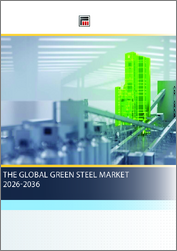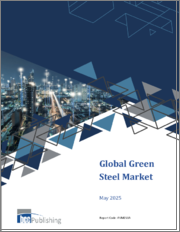
|
시장보고서
상품코드
1643952
아시아태평양의 지속가능한(재활용 및 그린) 철강 시장 : 최종 사용자용도별, 제품 유형별, 기술별, 국가별 - 분석과 예측(2024-2034년)Asia-Pacific Sustainable (Recycled and Green) Steel Market: Focus on End-User Application, Product Type, Technology, and Country-Level Analysis - Analysis and Forecast, 2024-2034 |
||||||
아시아태평양의 지속 가능한(재활용 및 그린) 철강 시장 규모는 2024년 1,756억 8,000만 달러에 달했습니다.
이 시장은 10.15%의 연평균 복합 성장률(CAGR)로 기록하여 2034년에는 4,618억 달러에 달할 것으로 예측되고 있습니다. 아시아태평양 시장은 엄격한 환경 규제와 저탄소 건축자재 수요 증가로 확대되고 있습니다. 재활용 절차 개선 및 수소 기반 환원 기술 등 강철 생산의 기술 개발이 중요한 요인이 되고 있습니다. 또한 전략적 제휴와 그린 인프라 프로젝트에 대한 투자를 통해 아시아태평양 철강 산업은 탄소에 대한 인식과 지속 가능성을 높이고 있습니다.
| 주요 시장 통계 | |
|---|---|
| 예측 기간 | 2024년-2034년 |
| 2024년 평가 | 1,756억 8,000만 달러 |
| 2034년 예측 | 4,618억 달러 |
| CAGR | 10.15% |
아시아의 지속 가능한(재활용 및 그린) 철강 시장은 환경 친화적인 건축자재에 대한 요구가 증가하고 까다로운 환경 규제에 대응하기위한 압력이 증가함에 따라 크게 확대되고 있습니다. 인프라, 자동차, 건설 등 이 지역의 산업이 보다 환경친화적인 사업으로 전환하는 가운데, 재활용그린스틸의 사용은 이산화탄소 배출량을 삭감하고 순환형 경제의 사고방식을 추진하는 중요한 수단으로 부상하고 있습니다.
수소를 이용한 환원법이나 리사이클 전략의 강화 등, 스틸 생산에 있어서의 기술 개발이 시장 성장의 주된 촉진요인이 되고 있습니다. 중국, 한국, 일본과 같은 국가들이 환경 친화적인 철강 생산 프로젝트에 투자하는 가운데 수소 기반의 강철 생산은 기존 방법을 대체하는 저탄소 대체 방법으로 점점 대중화되고 있습니다.
지속 가능한 철강 수요는 아시아태평양 철강 산업의 녹색 인프라 프로젝트에 대한 대규모 투자로 더욱 가속화되고 있습니다. 각국 정부는 규제, 보조금, 지원 정책을 통해 탄소 발자국을 줄임으로써 이러한 노력을 장려하고 있습니다.
아시아태평양의 지속 가능한 강철 시장은 환경 친화적인 건축자재에 대한 요구가 커짐에 따라 계속 확대될 것으로 예상됩니다. 이 지역이 지속가능한 목표를 달성하고 저탄소 미래로의 전환을 추진하기 위해서는 친환경 철강 생산이 필수적입니다.
이 보고서는 아시아태평양의 지속 가능한(재활용 및 그린) 철강 시장을 조사했으며, 시장 개요와 함께 최종 사용자용도별, 제품 유형별, 기술별, 국가별 동향 및 시장 진출기업 프로파일 등의 정보를 제공합니다.
목차
주요 요약
제1장 시장
- 동향 : 현재 및 미래의 영향 평가
- 공급망 개요
- 연구개발 리뷰
- 규제 상황
- 주요 세계적 사건별 영향 분석 - COVID-19 팬데믹, 러시아와 우크라이나 전쟁, 중동 위기가 지속 가능한(재활용 및 그린) 철강 시장에 미치는 영향
- 시장 역학 개요
- 주요 스틸 제조업체와 넷 제로 목표 목록
- 스타트업의 정세
- 세계 그린 철강 프로젝트와 개발
제2장 지역
- 지역별 개요
- 성장 촉진요인과 억제요인
- 아시아태평양
- 지역 개요
- 시장 성장 촉진요인
- 시장 성장 억제요인
- 용도
- 제품
- 아시아태평양(국가별)
제3장 시장 - 경쟁 벤치마킹 및 기업 프로파일
- 향후 전망
- 지리적 평가
- 기업 프로파일
- HBIS GROUP
- NIPPON STEEL CORPORATION
- POSCO
- Tata Steel
- China Baowu Steel Group Corporation Limited
- 기타 주요 지속 가능한 철강 제조업체 목록
- SAIL
- JSW
- Ansteel Group Corporation Limited
- ScrapBuk
- Element Zero
제4장 조사 방법
SHW 25.02.21Introduction to Asia-Pacific Sustainable (Recycled and Green) Steel Market
The Asia-Pacific sustainable (recycled and green) steel market was valued at $175.68 billion in 2024 and is projected to grow at a CAGR of 10.15%, reaching $461.80 billion by 2034. The APAC market is expanding due to stringent environmental regulations and rising demand for low-carbon building materials. Technological developments in steel production, such as improved recycling procedures and hydrogen-based reduction techniques, are important factors. Additionally, through strategic alliances and investments in green infrastructure projects, the APAC steel industry is growing more carbon-conscious and sustainable.
Market Introduction
| KEY MARKET STATISTICS | |
|---|---|
| Forecast Period | 2024 - 2034 |
| 2024 Evaluation | $175.68 Billion |
| 2034 Forecast | $461.80 Billion |
| CAGR | 10.15% |
The market for sustainable (recycled and green) steel in Asia is expanding significantly due to the growing need for eco-friendly building materials and the growing pressure to comply with strict environmental regulations. The use of recycled and green steel is emerging as a crucial way to lower carbon emissions and advance the ideas of the circular economy as the region's industries-such as infrastructure, automotive, and construction-move toward more environmentally friendly operations.
Technological developments in steel production, like hydrogen-based reduction methods and enhanced recycling strategies, are major drivers of the market's growth. As nations like China, South Korea, and Japan invest in green steel production projects, hydrogen-based steel production-which provides a low-carbon substitute for conventional methods-is becoming more and more popular.
The demand for sustainable steel is being further accelerated by the APAC steel industry's large investments in green infrastructure projects. Governments are encouraging these efforts by lowering carbon footprints through regulations, subsidies, and supportive policies.
The APAC sustainable steel market is expected to continue expanding as the need for environmentally friendly building materials rises. In order to help the region meet its sustainability goals and propel the shift to a low-carbon future, green steel production will be essential.
Market Segmentation
Segmentation 1: by End-User Application
- Transportation
- Building and Construction
- Furniture and Appliances
- Mechanical Equipment and Tools
- Packaging
- Others
Segmentation 2: by Product Type
- Recycled Steel
- Green Steel
Segmentation 3: by Technology
- Sustainable Steel
- Electric Arc Furnace (EAF)
- Blast Furnace-Basic Oxygen Furnace (BF-BOF)
- Others
- Green Steel
- Electric Arc Furnace (EAF)
Renewable - Electric Arc Furnace (R-EAF)
Hydrogen Direct Reduced Iron - Electric Arc Furnace (H2 DRI-EAF)
- Others
Segmentation 4: by Region
- Asia-Pacific: China, Japan, South Korea, India, Australia, and Rest-of-Asia-Pacific
How can this report add value to an organization?
Product/Innovation Strategy: The product segment helps the reader understand the different applications of the sustainable steel products available based on application (transportation, building and construction, furniture and appliances, mechanical equipment and tools, packaging, and others), product type (recycled steel and green steel), technology type (electric arc furnace (EAF), blast furnace-basic oxygen furnace (BF-BOF), and others. The market is poised for significant expansion with ongoing technological advancements, increased investments, and growing awareness of the importance of sustainable steel. Therefore, the Asia-Pacific sustainable steel business is a high-investment and high-revenue generating model.
Growth/Marketing Strategy: The Asia-Pacific sustainable steel market has been growing at a rapid pace. The market offers enormous opportunities for existing and emerging market players. Some of the strategies covered in this segment are mergers and acquisitions, product launches, partnerships and collaborations, business expansions, and investments. The strategies preferred by companies to maintain and strengthen their market position primarily include product development.
Competitive Strategy: The key players in the Asia-Pacific sustainable steel market analyzed and profiled in the study include manufacturers and recyclers. Additionally, a comprehensive competitive landscape such as partnerships, agreements, and collaborations are expected to aid the reader in understanding the untapped revenue pockets in the market.
Key Market Players and Competition Synopsis
The companies that are profiled in the report have been selected based on inputs gathered from primary experts and analyzing company coverage, product portfolio, and market penetration.
Some of the prominent names in the sustainable steel market are:
- HBIS GROUP
- NIPPON STEEL CORPORATION
- POSCO
- Tata Steel
- China Baowu Steel Group Corporation Limited
Table of Contents
Executive Summary
Scope and Definition
1 Markets
- 1.1 Trends: Current and Future Impact Assessment
- 1.1.1 Circular Economy and Recycling
- 1.1.2 Technological Advancements and Rising Research and Developments
- 1.1.3 Carbon Capture and Emission Reduction
- 1.2 Supply Chain Overview
- 1.2.1 Value Chain Analysis
- 1.2.2 Market Map
- 1.2.3 Pricing Forecast
- 1.3 Research and Development Review
- 1.3.1 Patent Filing Trend (by Number of Patents, Country)
- 1.4 Regulatory Landscape
- 1.5 Impact Analysis for Key Global Events- COVID-19 Pandemic, Russia/Ukraine War, or Middle East Crisis on Sustainable (Recycled and Green) Steel Market
- 1.5.1 COVID-19 Pandemic
- 1.5.2 Russia/Ukraine War or Middle East Crisis
- 1.6 Market Dynamics Overview
- 1.6.1 Market Drivers
- 1.6.1.1 Construction Industry's Shift toward Sustainable Materials
- 1.6.1.2 Government Regulations and Net-Zero Targets
- 1.6.1.3 Use of Renewable Energy Sources in Steel Production
- 1.6.2 Market Restraints
- 1.6.2.1 Limited Availability of Green Technologies and Infrastructure for Sustainable Steel Production
- 1.6.2.2 High Cost Associated with Implementing Green Steel Production Methods
- 1.6.3 Market Opportunities
- 1.6.3.1 Increasing Demand for Sustainable Infrastructure and Green Construction Projects
- 1.6.3.2 Rising Collaborations between Steel Producers and End Users
- 1.6.1 Market Drivers
- 1.7 List of Key Steel Manufacturers and Their Net-Zero Targets
- 1.8 Start-Up Landscape
- 1.8.1 Key Start-Ups in the Ecosystem
- 1.9 Global Green Steel Projects and Developments
2 Regions
- 2.1 Regional Summary
- 2.2 Drivers and Restraints
- 2.3 Asia-Pacific
- 2.3.1 Regional Overview
- 2.3.2 Driving Factors for Market Growth
- 2.3.3 Factors Challenging the Market
- 2.3.4 Application
- 2.3.5 Product
- 2.3.6 Asia-Pacific (by Country)
- 2.3.6.1 China
- 2.3.6.1.1 Application
- 2.3.6.1.2 Product
- 2.3.6.2 Japan
- 2.3.6.2.1 Application
- 2.3.6.2.2 Product
- 2.3.6.3 South Korea
- 2.3.6.3.1 Application
- 2.3.6.3.2 Product
- 2.3.6.4 India
- 2.3.6.4.1 Application
- 2.3.6.4.2 Product
- 2.3.6.5 Australia
- 2.3.6.5.1 Application
- 2.3.6.5.2 Product
- 2.3.6.6 Rest-of-Asia-Pacific
- 2.3.6.6.1 Application
- 2.3.6.6.2 Product
- 2.3.6.1 China
3 Markets - Competitive Benchmarking & Company Profiles
- 3.1 Next Frontiers
- 3.2 Geographic Assessment
- 3.3 Company Profiles
- 3.3.1 HBIS GROUP
- 3.3.1.1 Overview
- 3.3.1.2 Top Products/Product Portfolio
- 3.3.1.3 Top Competitors
- 3.3.1.4 Target Customers/End Users
- 3.3.1.5 Key Personnel
- 3.3.1.6 Analyst View
- 3.3.1.7 Market Share, 2023
- 3.3.2 NIPPON STEEL CORPORATION
- 3.3.2.1 Overview
- 3.3.2.2 Top Products/Product Portfolio
- 3.3.2.3 Top Competitors
- 3.3.2.4 Target Customers
- 3.3.2.5 Key Personnel
- 3.3.2.6 Analyst View
- 3.3.2.7 Market Share, 2023
- 3.3.3 POSCO
- 3.3.3.1 Overview
- 3.3.3.2 Top Products/Product Portfolio
- 3.3.3.3 Top Competitors
- 3.3.3.4 Target Customers/End Users
- 3.3.3.5 Key Personnel
- 3.3.3.6 Analyst View
- 3.3.3.7 Market Share, 2023
- 3.3.4 Tata Steel
- 3.3.4.1 Overview
- 3.3.4.2 Top Products/Product Portfolio
- 3.3.4.3 Top Competitors
- 3.3.4.4 Target Customers/End Users
- 3.3.4.5 Key Personnel
- 3.3.4.6 Analyst View
- 3.3.4.7 Market Share, 2023
- 3.3.5 China Baowu Steel Group Corporation Limited
- 3.3.5.1 Overview
- 3.3.5.2 Top Products/Product Portfolio
- 3.3.5.3 Top Competitors
- 3.3.5.4 Target Customers/End Users
- 3.3.5.5 Key Personnel
- 3.3.5.6 Analyst View
- 3.3.5.7 Market Share, 2023
- 3.3.1 HBIS GROUP
- 3.4 List of Other Key Sustainable Steel Manufacturers
- 3.4.1 SAIL
- 3.4.1.1 Overview
- 3.4.1.2 Top Products/Product Portfolio
- 3.4.1.3 Top Competitors
- 3.4.1.4 Target Customers/End Users
- 3.4.1.5 Key Personnel
- 3.4.1.6 Analyst View
- 3.4.1.7 Market Share, 2023
- 3.4.2 JSW
- 3.4.2.1 Overview
- 3.4.2.2 Top Products/Product Portfolio
- 3.4.2.3 Top Competitors
- 3.4.2.4 Target Customers/End Users
- 3.4.2.5 Key Personnel
- 3.4.2.6 Analyst View
- 3.4.2.7 Market Share, 2023
- 3.4.3 Ansteel Group Corporation Limited
- 3.4.3.1 Overview
- 3.4.3.2 Top Products/Product Portfolio
- 3.4.3.3 Top Competitors
- 3.4.3.4 Target Customers/End Users
- 3.4.3.5 Key Personnel
- 3.4.3.6 Analyst View
- 3.4.3.7 Market Share, 2023
- 3.4.4 ScrapBuk
- 3.4.4.1 Overview
- 3.4.4.2 Top Products/Product Portfolio
- 3.4.4.3 Top Competitors
- 3.4.4.4 Target Customers/End Users
- 3.4.4.5 Key Personnel
- 3.4.4.6 Analyst View
- 3.4.4.7 Market Share, 2023
- 3.4.5 Element Zero
- 3.4.5.1 Overview
- 3.4.5.2 Top Products/Product Portfolio
- 3.4.5.3 Top Competitors
- 3.4.5.4 Target Customers/End Users
- 3.4.5.5 Key Personnel
- 3.4.5.6 Analyst View
- 3.4.5.7 Market Share, 2023
- 3.4.1 SAIL
4 Research Methodology
- 4.1 Data Sources
- 4.1.1 Primary Data Sources
- 4.1.2 Secondary Data Sources
- 4.1.3 Data Triangulation
- 4.2 Market Estimation and Forecast



















